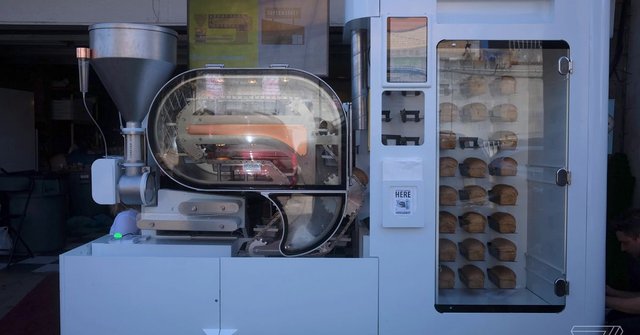A machine baked me bread today, and it was delicious. BreadBot attempts to automate bread-making in order to bring fresh loaves to massive grocers, like Walmart and Kroger. The team behind it, Wilkinson Baking Company, has worked on developing a prototype for 10 years, and now, finally, it’s debuting the device at SXSW in Austin, Texas this week.
The bot mixes, kneads, rolls out, and bakes fresh loaves of bread. One loaf takes about 90 minutes from start to finish and the machine rolls out fresh bread throughout the day with the help of loads of sensors. BreadBot can create most breads, except for sticky ones, like cinnamon buns and raisin breads. The company is still working on figuring out sourdough, too. But let me tell you about these sensors and the incredible amount of technology that went into making an automated, single loaf bread machine.
We’ll start from the top, although I’ll say you can also watch the whole process on the company’s website. The machine features a built-in hopper that holds dry ingredients, like flour and yeast, for up to 100 loaves. (The prototype I saw only had enough capacity for 50 loaves.) Every six minutes, enough dry ingredients for one loaf are dropped from the hopper and mixed with water. An ultrasonic measuring system determines when the water has reached the appropriate amount. Then, an automated mixer kneads the dough, which you can see below. All of this is powered by a built-in PC in the base of the machine.
That kneaded dough then drops onto a conveyor belt, where a laser detects its presence and times how long it takes for the dough to compress. Harder dough will take longer to get through this rolling out process. The machine remembers this time and adjusts the amount of water it adds to the following loaves to optimize them for quicker roll out.
The dough then drops into a baking pan and makes its way into a proofing oven that’s set for high humidity and a relatively warm temperature. It takes about 45 minutes for the dough to rise. It then makes its way up to the baking oven, which is hot with low humidity. The baking process takes 40 minutes.
As the bread comes out of the oven, a laser will determine the bread’s height and make further recipe adjustments to ensure the following loaves reach their height goals. A photo is also taken for color matching to ensure the bread is the exact shade of brown it should be. This, again, will be used to make adjustments. A vending machine arm then drops the bread off in a user-facing display, so customers can choose what loaf they want to buy. The arm will also fetch the bread for them.
A front-mounted tablet visualizes where bread is, so customers can choose the exact loaf they want. They’ll see information about the bread, too, like how old it is and how it was baked. The tablet will also use facial recognition software to estimate a customer’s age and offer stores data about who uses the machine. This could also be used to offer people more personalized coupons, although I’m told that data is only stored in the aggregate and that actual photos are not kept. My favorite thing about the machine is its internal vent that pumps out the smell of fresh bread, so shoppers know what they’re missing.
I tried a multigrain slice today, and it was quite tasty. It’s hot here in Austin, so the bread was a little moist and sticky. The company told me the prototype wasn’t taking all the various automated measurements into account because it wasn’t yet set up to do so, so they had to make adjustments on their own. They adjusted the water levels as I was leaving.
The idea is to lease these machines to big stores, and eventually let customers pre-order specific bread recipes, although that’ll be much later because the machine can only currently handle one recipe at a time. The company also wants to get all these machines online so they can talk to each other and learn from their recipe experiences. A machine in Colorado will let a machine in Miami know how it bakes bread in specific temperature and humidity situations and vice versa.
I can’t believe how much tech goes into baking a loaf of bread, but I guess it makes sense. Humans won’t be monitoring the device much at all, so it needs to be completely self-sufficient. I’m fully on-board with buying machine-baked bread, especially because I don’t have a bakery nearby my apartment and because I’m definitely never going to bake my own.
Hi! I am a robot. I just upvoted you! I found similar content that readers might be interested in:
https://thesiliconpost.com/breadbot-is-an-insanely-over-engineered-gadget-just-for-baking-loaves-of-bread-the-silicon-post/
Downvoting a post can decrease pending rewards and make it less visible. Common reasons:
Submit